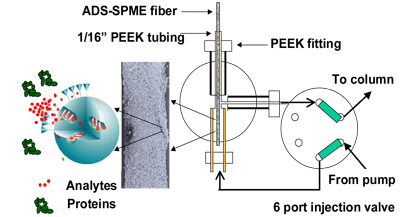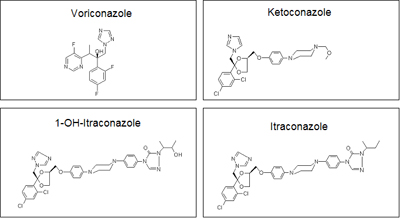Method development on-line SPE-LC
Rosa MorelloLevelBasic
In the next paragraphs we explain the operational procedure and steps to develop a method for on-line SPE-LC of biofluids.
In addition a number of examples are given.
Step 1a
Step 1a:
- Fractionation of biofluid(s) into analyte(s) and sample matrix (= Adsorptive extraction and enrichment of analyte(s))
- Determine complete elution of sample matrix = tM [min]
- Calculate valve switching time = tV1 [min] (= End of fractionation step and coupling of SPE-column with LC-column )
Determine tM
Instrumental set-up for the determination of tM.
Instrumental Set-up: Determination of tM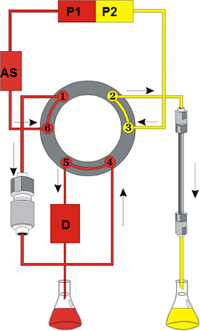
Procedure :
1. Couple SPE-column directly to an UV detector set at 280 nm
2. Inject biofluid (e.g. plasma) and record elution profile of sample matrix
- Use a mobile phase compatible with the sample:
- amount of organic modifier
- pH
- Use an adequate flow rate for loading the SPE-column with the sample
Example: Determination of tM: Human Plasma
Determination of tM: Human Plasma 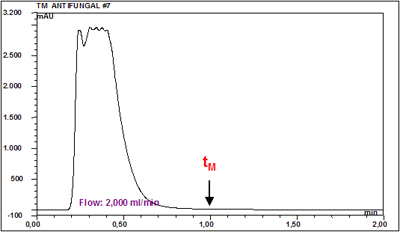
Step 1b
- Fractionation of biofluid(s) into analyte(s) and sample matrix
- Then determine breakthrough of analyte(s) = tA [min]
Examples of compounds (Antimycotics / Antifungals) that we use as example in this tutorial:
Determine tA
Instrumental set up to determine tA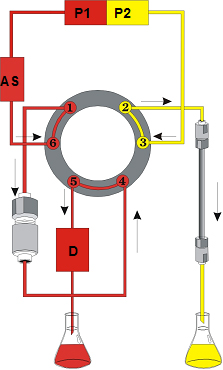
Procedure:
- Couple SPE-column to appropriate detector
- Use mobile phase composition and flow-rate as for tM
- Inject analyte(s) and record elution profile Important: Conditio sine qua non : tA > tM
Example: the determination of tA: Antimycotic (Voriconazole)
Determination of tA: Antimycotic (Voriconazole)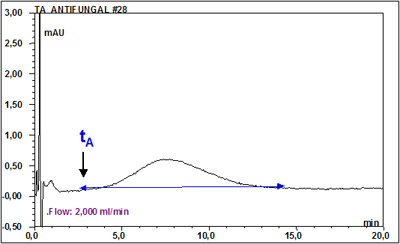
Step 2.
Step 2 :
- Transfer of analyte(s) from SPE-column to analytical HPLC-column
- Determine complete elution of analyte(s) = tT [min]
- Calculate valve switching time = tV2 [min] = End of transfer step and decoupling of SPE-column from LC-column
Instrumental Set-up : Determination of tT
Instrumental Set-up: Determination of tT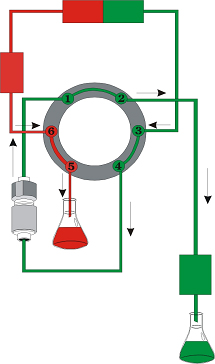
Procedure:
- Load analyte(s) onto SPE-column (mobile phase I)
- Switch valve
- Use mobile phase II
- Desorb analyte(s) and record elution profile with a directly coupled detector
Example of the determination of tT: Antimycotic (Itraconazole)
Determination of tT: Antimycotic (Itraconazole)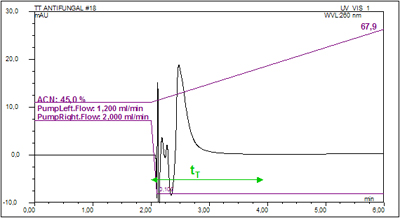
Calculation of valve switching times
tV1 = ½ (tM + tA ) = ½ (1 + 3) = 2 min
tV2 = tV1 + tT + 1 = 5 min
Calculation of valve switching times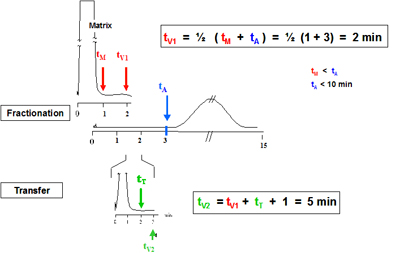
Examples
On-line SPE-LC-UV of Antimycotics: Separation of a Standard Mixture
On-line SPE-LC-UV of Antimycotics: Memory Effect (Carry Over)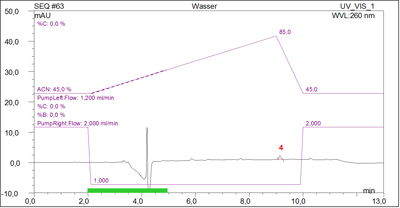
Memory Effect and Countermeasure: Extension of tT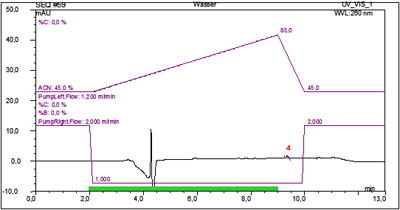
Memory Effect: Additional wash of SPE-column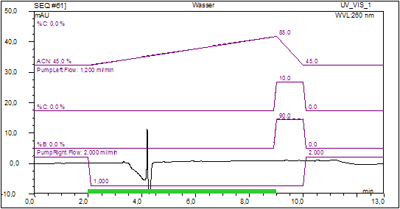
On-line SPE(RP/SEC)-LC-UV Analysis of Antimycotics in Human Plasma: Final Protocol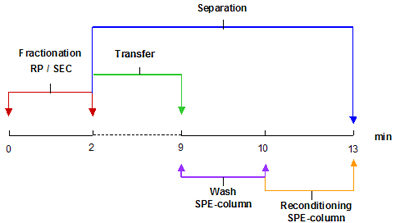
On-line SPE-LC-UV Analysis of Antimycotics: Spiked Human Plasma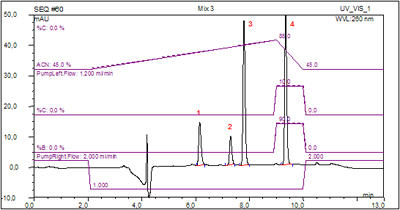
On-line SPE-LC-UV Analysis of Antimycotics: Patient Plasma On-line SPE-LC-UV Analysis of Antimycotics: Patient Plasma
On-line SPE-LC-UV Analysis of Antimycotics: Patient Plasma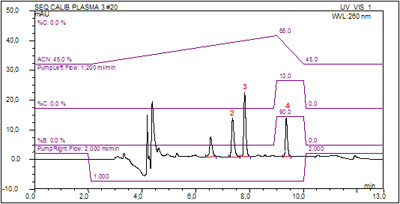
Therapeutic Drug Monitoring of Antimycotics: Method Comparison On-line SPE-LC-UV versus Offline Precipitation and LC-MS/MS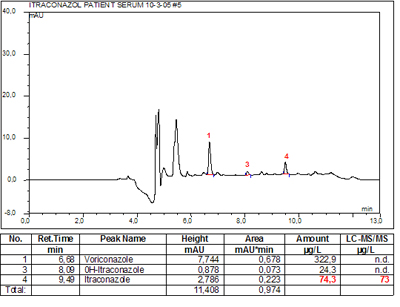
Optimization
Goals:
- Maximizing Analyte enrichment SPE column lifetime
- Minimizing Retention of interfering compounds „Matrix Effects“
Variables:
- SPE column packing material
- Mobile phase composition
- pH
- Additives (ion-pair reagent, org. modifier)
- Volume
- Sample
- Fractionation / Transfer step
- SPE column size
Optimization of the transfer step
- Goal: Peak compression (in-line enrichment)
- Approach
- Mobile phase composition
- Post-column dilution
- Thermo-Desorption
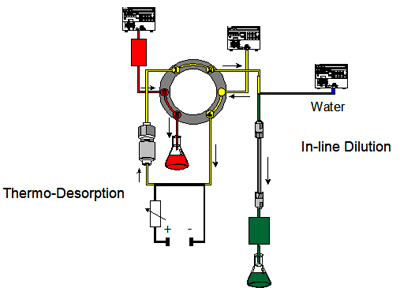
On-line SPE-LC Quo Vadis?
SPE-LC will have two developments, one in the direction of miniaturization, the other is downsizing. We will describe both:
Miniaturization
Advantages:
- Decreased diffusion path length improves separation efficiency
- Reduced consumption of sample (human, animal) and mobile phases
- Diminished production of chemical and biohazardous waste
- Significant reduction of analysis time
- Increased throughput
- Multiple analyses from a single sample
- Increased sensitivity of concentration dependent detection modes e.g. UV or ESI-MS
| Column ID | Flow-rate | |
| conventional LC | 3.2 – 4.6 mm | 0.5 – 2.0 mL/min |
| microbore LC | 1.5 – 3.2 mm | 100 – 500 µL/min |
| micro LC | 0.5 – 1.5 mm | 10 – 100 µL/min |
| capillary LC | 150 – 500 µm | 1 – 10 µL/min |
| nano LC | 10 – 150 µm | 10 – 1000 nL/min |
Source: Szumski M et al., Critical Reviews in Analytical Chemistry 32 (2002) 1-46
Downsizing
| \ Method Column \ | conventional | microbore |
| SPE-column | 20 x 4 mm ID | 20 x 1 mm ID |
| Analytical column | 150 x 4.6 mm ID | 50 x 2.1 mm ID |
On-line SPE(RP/SEC)-LC/UV of Antimycotics: Comparison of conventional with downsized SPE and LC columns (Click for full view)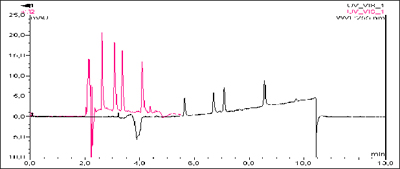
| Conventional | Microbore | Reduction | |
| Overall analysis time [min] | 13 | 5.5 | 2.4 fold |
| Eluent consumption / analysis cycle [mL] | 26 | 4.4 | 5.9 fold |
| Sample injection volume [µL] | 2.5 fold | ||
| Increase | |||
| Response Factor (Itraconazole) | 1 ng = 0.23 mAU | 1 ng = 0.93 mAU | 4.0 fold |
| ESI-MS compatibility | limited (1.2 mL/min) | ideal (0.4 mL/min) | - |
Solid Phase Micro Extraction: SPME Fiber and HPLC Interface ...... Solid Phase Micro Extraction: SPME Fiber and HPLC Interface